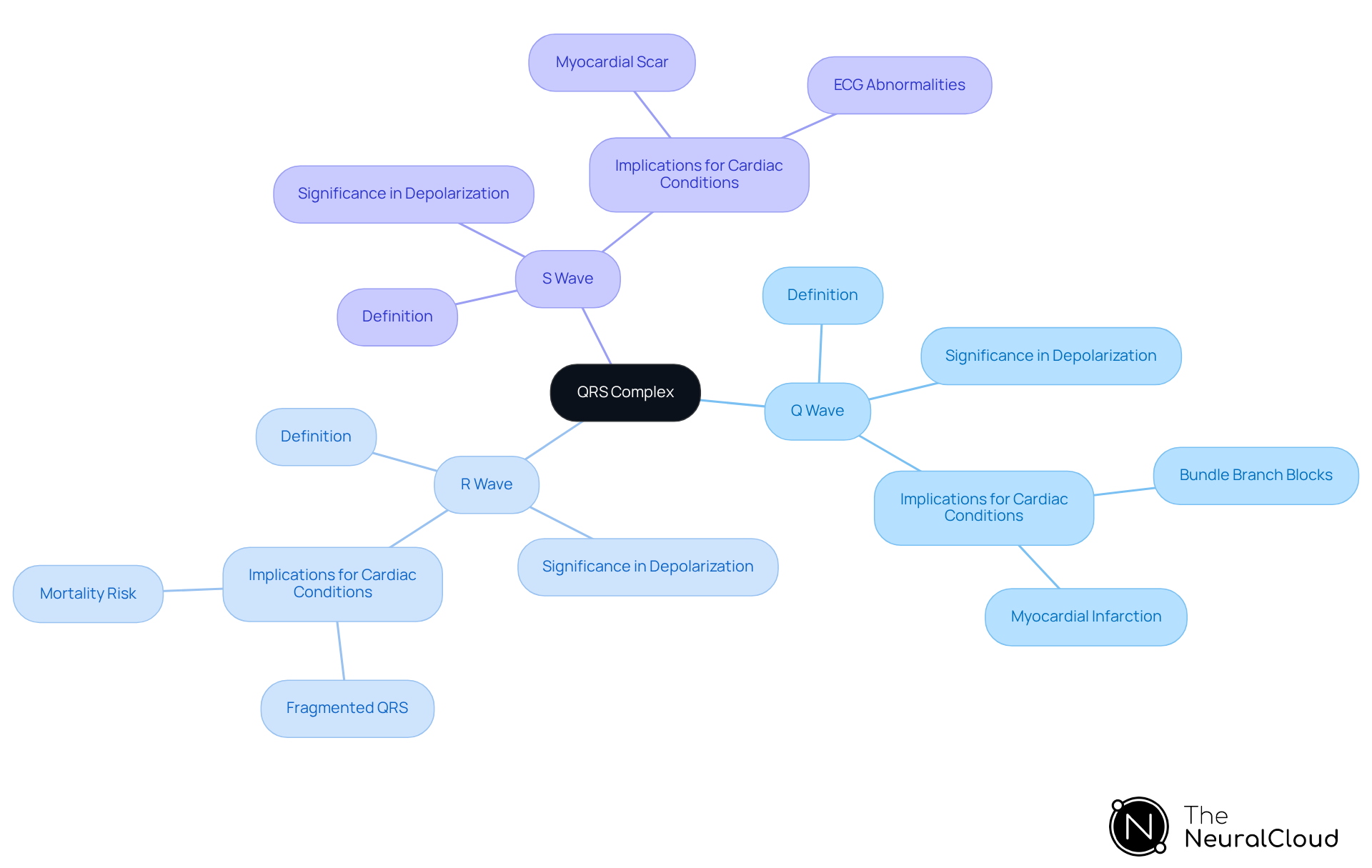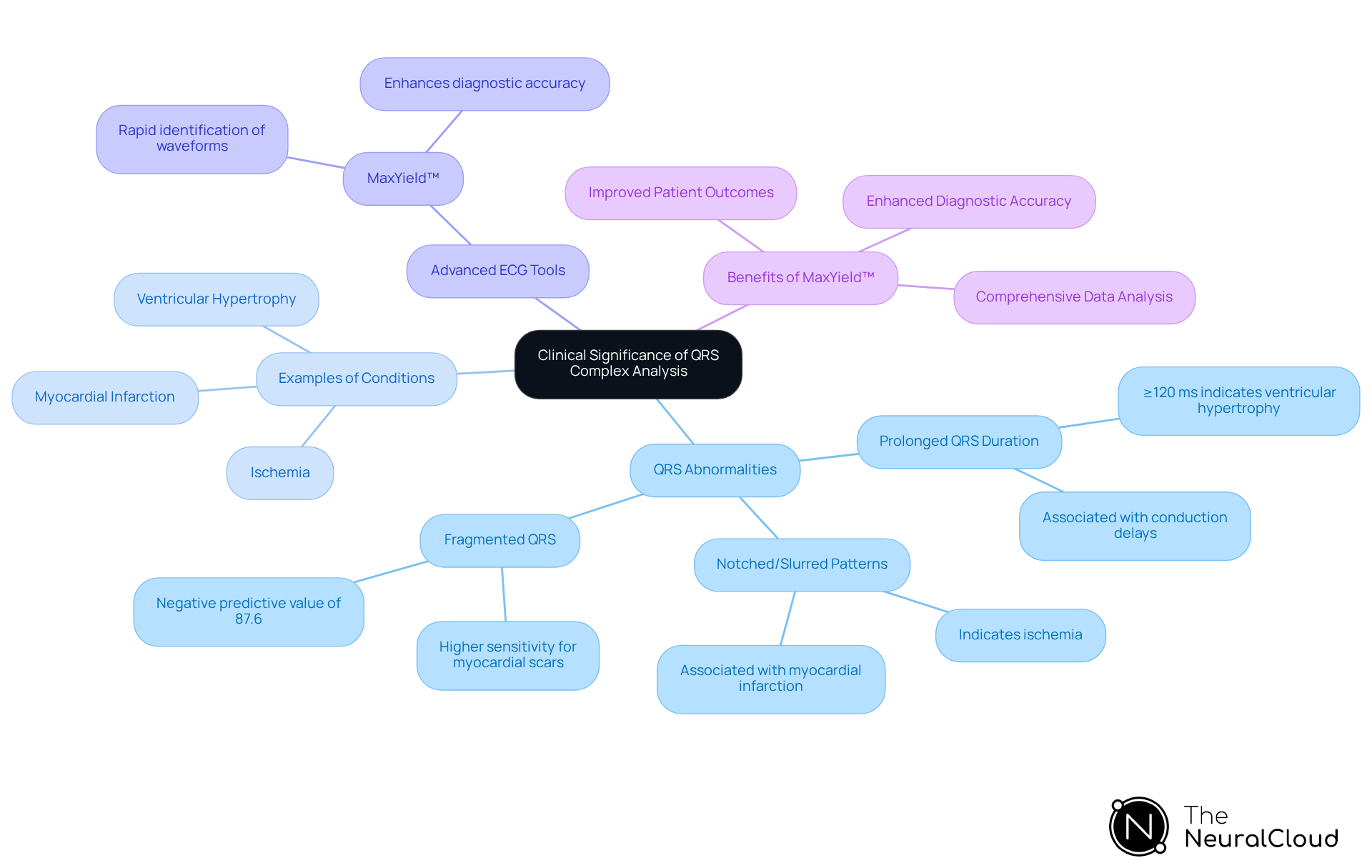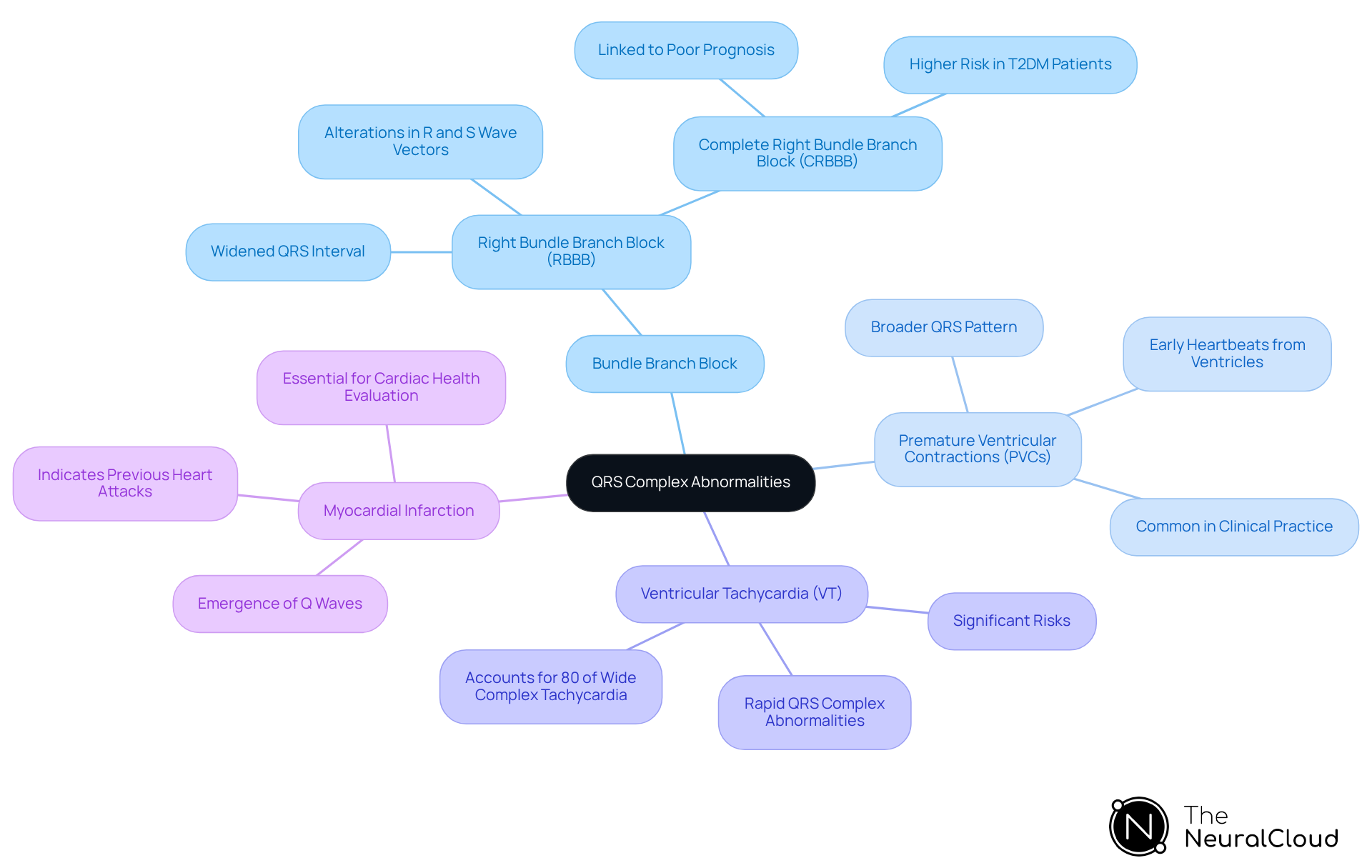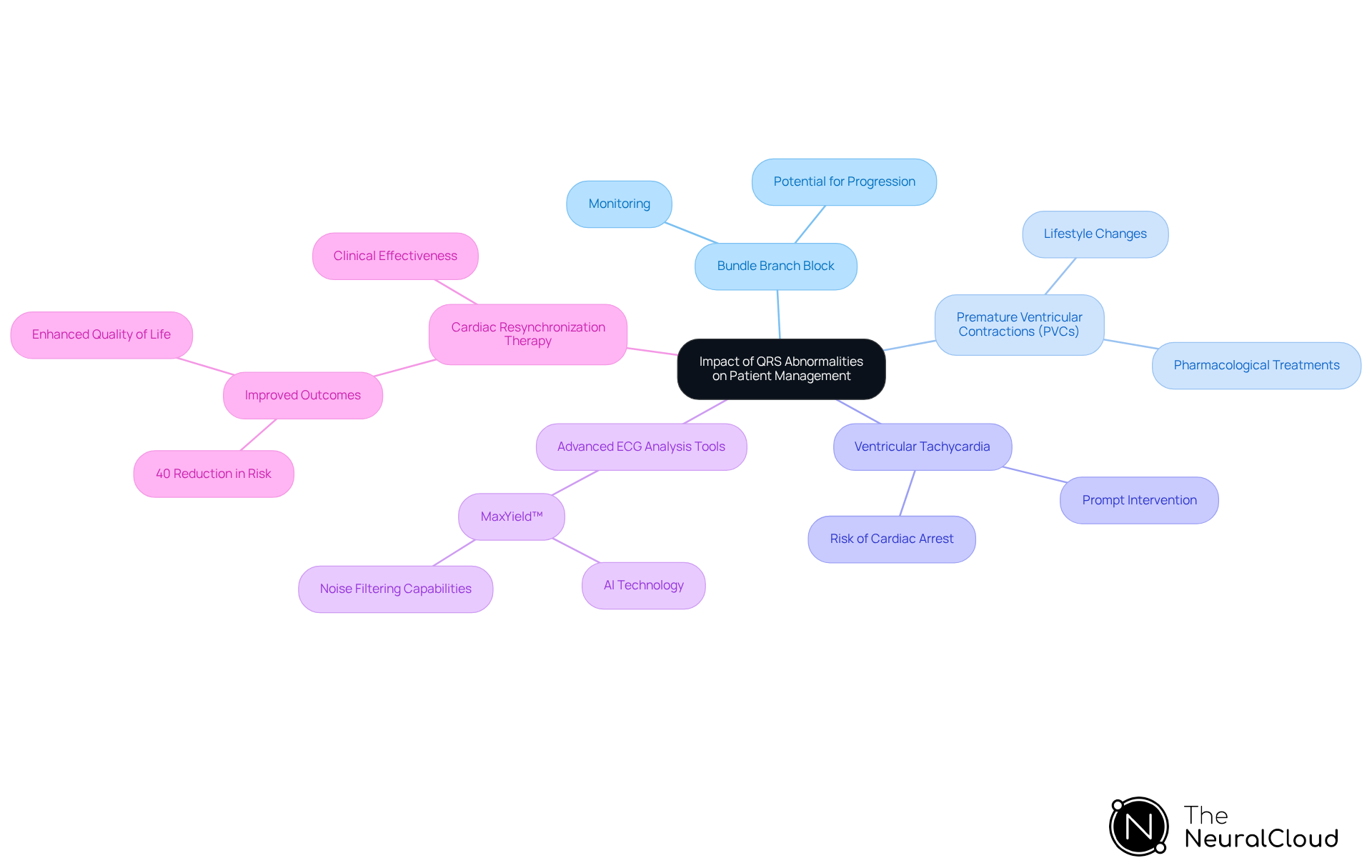Overview
QRS complex abnormalities pose significant challenges for cardiac health, acting as key indicators of various heart conditions, including bundle branch blocks, myocardial infarction, and ventricular tachycardia. These challenges highlight the need for advanced ECG analysis tools that can accurately detect such abnormalities.
MaxYield™ stands out as a powerful platform designed to enhance ECG analysis. Its features include advanced algorithms that improve the detection of QRS complex abnormalities, providing healthcare professionals with precise data to inform their clinical decisions. This capability allows for timely interventions, which are crucial in managing heart conditions effectively.
The advantages of using MaxYield™ are clear. By leveraging its advanced features, healthcare professionals can enhance patient outcomes through informed management strategies. The platform not only streamlines the analysis process but also supports clinicians in making critical decisions that can save lives.
In summary, MaxYield™ addresses the complexities of ECG analysis, offering features that translate into significant benefits for healthcare providers. With its focus on accuracy and efficiency, it empowers professionals to deliver better care to their patients.
Introduction
Understanding the QRS complex is crucial for anyone involved in cardiac care. This essential component of the ECG waveform provides valuable insights into heart function. Abnormalities in the QRS complex can indicate serious conditions, such as myocardial infarctions and various arrhythmias. Therefore, accurate interpretation is vital for effective patient management.
Despite its importance, the complexities of QRS morphology can challenge clinicians. Advanced tools and techniques can enhance the detection and analysis of these abnormalities, ultimately improving patient outcomes. The MaxYield™ platform addresses these challenges by offering features that streamline ECG analysis, making it easier for healthcare professionals to interpret results accurately.
Define the QRS Complex: Structure and Function
The QRS pattern is a pivotal element of the ECG waveform, signifying the rapid depolarization of the ventricles. It comprises three distinct components: the Q wave (the initial downward deflection), the R wave (the subsequent upward deflection), and the S wave (the following downward deflection). Collectively, these waves represent the electrical impulses that initiate ventricular contraction, which is vital for effective blood circulation.
Understanding the typical morphology of the QRS structure is crucial, as QRS complex abnormalities can indicate serious heart conditions. For instance, bundle branch blocks can manifest as altered QRS shapes, while myocardial infarction may present with QRS complex abnormalities, including fragmentation. Recent studies indicate that fragmented QRS (f-wQRS) is prevalent in approximately 47.2% of individuals post-myocardial infarction, highlighting its potential as a prognostic marker for mortality. Specifically, f-wQRS has been identified as an independent predictor of mortality, with a sensitivity of 86.8% and a specificity of 92.5% for diagnosing myocardial scar in patients with coronary artery disease.
Clinicians must be proficient in recognizing these morphological features to facilitate accurate diagnosis and treatment planning. The prevalence of normal QRS shape morphology varies, with studies indicating that QRS complex abnormalities are more frequent in certain demographics, such as older males, where the occurrence of fragmented QRS can reach as high as 49% in myocardial infarction survivors.
To enhance the efficiency of ECG analysis, Neural Cloud Solutions' MaxYield™ platform offers advanced noise filtering and automated labeling capabilities. Here are some key features of MaxYield™:
- Advanced Noise Filtering: Reduces interference in ECG recordings, ensuring clearer data.
- Automated Labeling: Streamlines the identification of QRS patterns, saving time for healthcare professionals.
By swiftly isolating and examining QRS patterns, MaxYield™ converts noisy recordings into detailed insights, allowing clinicians to identify cardiac events with enhanced precision. This underscores the importance of continuous education and training in ECG interpretation, as the ability to discern normal from QRS complex abnormalities is crucial for effective cardiac care.

Explore Clinical Significance: Importance of QRS Complex Analysis
The examination of the QRS structure is essential in clinical practice, providing vital insights into the heart's electrical conduction system. QRS complex abnormalities can signify a range of conditions, from harmless variations to serious arrhythmias. For example, a prolonged QRS duration, defined as ≥120 ms, may suggest ventricular hypertrophy or conduction delays, while QRS complex abnormalities such as notched or slurred QRS patterns can indicate ischemia or myocardial infarction. Recent studies have shown that the presence of fragmented QRS complexes (fQRS) is associated with a higher sensitivity for detecting myocardial scars, boasting a negative predictive value of 87.6%. This underscores the significance of precise QRS analysis in identifying individuals at risk for adverse outcomes associated with QRS complex abnormalities.
Utilizing advanced ECG analysis tools, such as MaxYield™ from Neural Cloud Solutions, healthcare professionals can significantly enhance their diagnostic accuracy. MaxYield™ quickly identifies P, QRS, and T wave onsets, offsets, and time-series intervals, enabling the swift processing of ECG data. This allows for prompt interventions that can improve patient outcomes. For instance, in a study involving hospitalized COVID-19 patients, those exhibiting wide QRS complexes and lateral ST-T segment abnormalities were found to have worse clinical outcomes. In fact, in-hospital mortality was more than six-fold higher in individuals with elevated cardiac Troponin T levels. This emphasizes the need for vigilant monitoring of QRS complex abnormalities.
Understanding the clinical importance of QRS complex abnormalities empowers clinicians to make informed decisions about management and treatment strategies. As healthcare continues to evolve, the integration of sophisticated ECG analysis technologies like MaxYield™ will be pivotal in optimizing patient care. The benefits of using MaxYield™ include:
- Enhanced diagnostic accuracy through rapid identification of waveforms.
- Improved patient outcomes via timely interventions.
- Comprehensive data analysis that supports clinical decision-making.
In conclusion, the adoption of advanced ECG analysis tools is crucial for enhancing the overall effectiveness of cardiac assessments.

Identify QRS Complex Abnormalities: Types and Characteristics
QRS complex abnormalities can manifest in various forms, each with unique characteristics that are crucial for accurate diagnosis. The most prevalent types include:
-
Bundle Branch Block (BBB): This condition arises from a delay in conduction through one of the bundle branches, leading to a widened QRS interval. Right Bundle Branch Block (RBBB) is typically recognized on a 12-lead ECG by alterations in the R and S wave vectors. Notably, Complete Right Bundle Branch Block (CRBBB) has been linked to poorer prognoses in patients with cardiovascular issues, especially those with Type 2 Diabetes Mellitus (T2DM).
-
Premature Ventricular Contractions (PVCs): These early heartbeats originate from the ventricles and often result in QRS complex abnormalities, which manifest as a QRS pattern that appears broader and has a different shape compared to normal beats. While the prevalence of PVCs can fluctuate, they are frequently encountered in clinical practice.
-
Ventricular Tachycardia (VT): Characterized by a series of rapid QRS complex abnormalities, VT can pose significant risks and necessitates immediate medical attention. Understanding the underlying causes of VT is vital, as it accounts for approximately 80% of wide complex tachycardia cases, particularly in individuals with existing cardiovascular conditions.
-
Myocardial Infarction: QRS complex abnormalities, including the emergence of Q waves, can signify previous heart attacks. Recognizing these changes is essential for evaluating cardiac health and informing treatment strategies.
By utilizing advanced ECG analysis platforms like MaxYield™, clinicians can automate the detection of these abnormalities, greatly improving the speed and accuracy of assessments. This technology not only enhances workflow efficiency but also supports the early identification of potentially life-threatening conditions.

Assess Implications: Impact of QRS Abnormalities on Patient Management
Management strategies for patients are significantly influenced by QRS complex abnormalities. For instance, those diagnosed with bundle branch block need careful monitoring due to the potential for progression to more severe conduction issues. The detection of premature ventricular contractions (PVCs) often leads healthcare providers to suggest lifestyle changes or initiate pharmacological treatments to reduce the risk of complications. In cases of ventricular tachycardia, prompt intervention is critical to prevent cardiac arrest, which emphasizes the urgency of addressing QRS complex abnormalities.
Advanced ECG analysis tools, like Neural Cloud Solutions' MaxYield™, greatly enhance healthcare professionals' ability to detect and assess the clinical implications of QRS complex abnormalities. MaxYield™ utilizes state-of-the-art AI technology to convert lengthy and noisy ECG recordings into clear, precise signals, enabling the swift isolation of essential data even in challenging conditions. Research published in the New England Journal of Medicine shows that patients with a prolonged QRS interval experience a 40% reduction in the risk of death or hospitalization for worsening heart failure when treated with cardiac resynchronization therapy. This proactive approach, supported by MaxYield™'s advanced noise filtering capabilities, allows clinicians to customize treatment plans that not only improve patient outcomes but also optimize resource allocation within clinical settings.
Moreover, the impact of QRS complex abnormalities shapes treatment strategies, as evidenced by case studies demonstrating significant improvements in functional capacity and quality of life for patients receiving targeted therapies. By harnessing these insights and the efficiency of MaxYield™, healthcare providers can make informed decisions that enhance patient care and clinical effectiveness.

Conclusion
In evaluating cardiac health, the QRS complex stands out as a crucial marker, reflecting the swift electrical activity that propels ventricular contraction. For clinicians, grasping its structure and understanding the implications of any abnormalities is vital for delivering effective patient care. This tutorial has delved into the complexities of the QRS complex, underscoring how variations in its morphology can signal a spectrum of cardiac conditions, ranging from benign to life-threatening.
Key insights include:
- The clinical importance of QRS analysis
- The various types of abnormalities such as bundle branch blocks and ventricular tachycardia
- The role of advanced ECG analysis tools like MaxYield™ in boosting diagnostic accuracy
Recognizing these abnormalities not only facilitates timely diagnosis but also shapes treatment strategies that can significantly enhance patient outcomes.
Given the critical nature of QRS complex abnormalities, it is essential for healthcare professionals to remain updated on the latest research and technologies in ECG analysis. By utilizing advanced tools and being acutely aware of the implications of QRS variations, clinicians can optimize patient management and contribute to improved health outcomes. Integrating such technologies into clinical practice will be pivotal in tackling the challenges posed by cardiac conditions, ultimately elevating the quality of care provided to patients.
Frequently Asked Questions
What is the QRS complex in an ECG waveform?
The QRS complex is a crucial part of the ECG waveform that signifies the rapid depolarization of the ventricles. It consists of three components: the Q wave (initial downward deflection), the R wave (subsequent upward deflection), and the S wave (following downward deflection).
Why is the morphology of the QRS complex important?
The morphology of the QRS complex is important because abnormalities can indicate serious heart conditions. For example, altered QRS shapes can be indicative of bundle branch blocks or myocardial infarction.
What is fragmented QRS (f-wQRS) and its significance?
Fragmented QRS (f-wQRS) is a type of QRS complex abnormality that is prevalent in approximately 47.2% of individuals post-myocardial infarction. It has been identified as an independent predictor of mortality, with a sensitivity of 86.8% and specificity of 92.5% for diagnosing myocardial scar in patients with coronary artery disease.
Who is more likely to have QRS complex abnormalities?
QRS complex abnormalities are more frequent in certain demographics, particularly older males, where the occurrence of fragmented QRS can reach as high as 49% in myocardial infarction survivors.
How can technology assist in analyzing the QRS complex?
Neural Cloud Solutions' MaxYield™ platform enhances ECG analysis by providing advanced noise filtering to reduce interference in ECG recordings and automated labeling to streamline the identification of QRS patterns, thus saving time for healthcare professionals.
What are the benefits of using MaxYield™ for ECG analysis?
MaxYield™ converts noisy ECG recordings into clearer data and detailed insights, allowing clinicians to identify cardiac events with enhanced precision, which is essential for effective cardiac care.
Why is continuous education important for clinicians regarding ECG interpretation?
Continuous education is vital for clinicians because the ability to discern normal from abnormal QRS complexes is crucial for accurate diagnosis and treatment planning in cardiac care.






